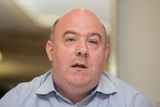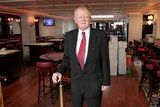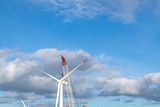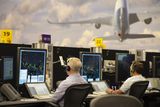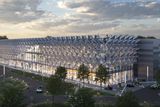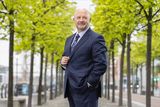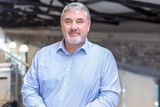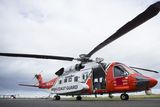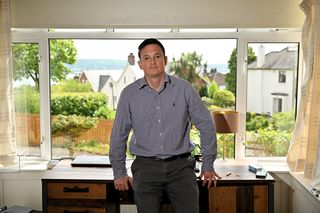Ryanair Labs: 'A startup within an airline'
Ryanair aims to double its passenger numbers by 2024 - and the engine room of this ambitious growth plan is its new digital 'Labs' at a north Dublin HQ
BEANBAGS AND GIANT CHESS: John Hurley, CTO of Ryanair, in the HQ — which looks suspiciously like an typical start-up. Photo: Gerry Mooney
Thirty years after Ryanair first began operating from a prefab at Waterford Airport, Ryanair Labs - "a tech startup within an airline" - is where a highly skilled team of analysts, data scientists, designers and software developers is aiming to make the low-cost airline as digitally sophisticated and customer-friendly as the likes of Amazon.
At its new €18m HQ near Dublin Airport I have a brief look into what might be described as the beating heart of the airline - its operations room, where a huge screen shows every one of the hundreds of its 1,600 daily flights that are in the air at any time. (Remember, 189 destinations and 30 countries.) Its staff are quietly overseeing all the arrivals and departures, 95pc of which are on time - according to an indicator on the wall. There's no trumpet fanfare.
On the floor above, there are brightly coloured partitions and walls, well-appointed staff kitchens (albeit not stocked with the appetising snacks and goodies you'd find at Google) and flags of about a dozen staff nationalities hanging over one section. There's a games room with a pool table, table football, Xboxes, retro arcade machines, giant chessboards and in one lobby, a big model of a plane.
The meeting rooms have names like 'the cockpit,' and in one, the base of the large table is made from an old airplane engine. Adorning the walls are huge photos of Ryanair jets, bears and Lego men. Another is of a stand at Man Utd's home ground, Old Trafford - a surprise given that CEO Michael O'Leary supports Man City.
In one of the Labs offices I meet Corkman John Hurley, who is overseeing the digitally led transformation of the organisation that's taken shape here since late last year. A move that was identified as vital in late 2013, after O'Leary admitted poor customer service had upset people and led to the airline losing business, resulting in two profit warnings. It is also central to its aim to fly 160m passengers a year by 2024 (up from 90m last year) in its €15bn fleet of 180 new Boeing 737s.
A UCC computer science graduate who began coding when he was 11, Hurley previously spent eight years overseeing similar stuff at Barry O'Callaghan's education publisher Houghton Mifflin Harcourt. On his wall is a big picture of two children playing with a trolley, and above it the slogan: "Dream things that never were and say why not?"
In the open-plan section nearby another says: "Unless it's crazy, ambitious and delusional, it's not worth our time."
Although O'Leary, no stranger to crazy PR stunts and perhaps more realistic ambitions, forbade his employees to charge their mobile phones in the office, and suggested they take free pens from hotels to save the company money some years ago, the Labs initiative is a significant investment. The 160 salaries, perhaps averaging €50k each, suggests that at a minimum, it's an €8m operation. Hurley declines to comment, but reveals it will keep growing, to more than 200 staff.
Growth could also come through acquisitions. With €3bn in the bank, Ryanair could afford to buy any startup that it saw as a good fit for the Labs.
"We wouldn't rule that out, and because of who we are, a lot of people make themselves known to us," he adds.
How closely involved is the Mullingar multimillionaire?
"We speak every second day. He attends most fortnightly demonstrations of our progress, and is not hands-off by any means. Our offices are on the same floor here, and he's very interested in what we're doing."
Plenty of evidence of the Labs staff's efforts is visible on many of the walls nearby. Hundreds of carefully ordered post-it notes of various colours are stuck in long rows - and other notes are written in marker on the glass partitions and white walls; the results of lots of brainstorming.
Among those directing this work are a number of recruits in their late 20s or mid-30s who have previously worked for various well-known companies.
Head of user experience Keith Tormey, a design and multimedia graduate, has 14 years' experience across the finance, gaming, enterprise software and media industries, notably at Fidelity Investments and the BBC.
"I was fascinated by the changes happening here over the past 18 months, so when the opportunity came to work here I jumped at it. This is one of the biggest airlines in the world and we're building a platform that will be used by 100 million people this year, so it was a no-brainer. People that come to work here are really surprised by the pace at which we work. The dynamic is very similar to that of a start-up, you're working with an extremely creative and talented bunch of people."
Design chief Alan Power has 12 years' digital design experience and previously worked for Paddy Power.
"When I joined, there was no style guide in place that dictated how our app and website would look; all we had was our brand colours and not much else. Over a number of months some of us worked closely with colleagues in other parts of the business to figure out exactly how Ryanair want to be perceived.
"It's been a great experience watching the new website come together. I saw moving to the Labs as a chance to really make a dent in the travel industry. It's a huge playing field to explore new ideas," he enthuses - his latter remark echoing the sentiments of his colleague Judyta Holubowicz, a Polish digital media graduate and key member of the product development team who previously worked for Distilled Media Group.
Research and usability head honcho Mark Kelly's CV includes stints at Cisco, Jaguar Land Rover, and in R&D at Honda.
"A Ryanair flight was the first online purchase I ever made. They disrupted European travel with low-cost flights and now they're disrupting the digital travel experience, so I wanted to be part of that," he says.
And it'd be a poor show if no one here had worked for another airline or had a stronger connection to flying. Digital marketing executive and graduate Dani Ryan has not only previously worked for Cityjet and Aer Arann, but as the holder of a pilot's licence, also enjoys taking to the skies at weekends.
Other employees have joined from a variety of startups and US tech giants, but Hurley won't elaborate or discuss pay levels.
Not being in the city's Silicon Docks tech hub is "a challenge," he admits. Many sought-after digital whizzes who can pick and choose where they work prefer to live close to their city centre workplaces and all its amenities. North Dublin is too far out from where it all happens, apparently.
The airline's cash pile means it could have easily splurged on a city centre headquarters, or perhaps even just a smallish one for the Labs staff; and it almost certainly would have been a good investment play as well.
In its early years, the airline had a lavish city centre HQ that O'Leary once described as "a sexy shambles" - but having the tech wizards work in the same building as their colleagues in other key functions of the company is important. Labs is the engine room that will drive its growth through winning new customers, keeping existing ones and eating its rivals' lunch. And as it continues to make an even bigger mark on the travel landscape in this way, so the senior Labs recruits see their opportunity to make their mark too, shaping how exactly it goes about that.
In practice, this means they complete incremental improvements of the website and smartphone app, working towards more substantial updates, in two-week "sprints."
"What we do has to be enterprise standard, but in a start-up type environment," is how Hurley describes it. They're at the leading edge of the company-wide IT system, which underpins and drives the whole business, he adds.
"Ryanair processes 250,000 to 300,000 bookings a day, and more than 40 million people a month use the website, so it has to function extremely fast. We monitor its performance down to the millisecond. It's our front door; it takes nearly all the bookings. While our old one was like an obstacle course, the updated one last year went from 17 clicks to book a flight to five, and we'll continue to improve on that."
An updated version of its app that launched last year saw the average booking time almost halved, from 3 minutes 47 seconds down to 1 minute 54 seconds. It now opens very quickly too; it previously took up to 14 seconds.
"We've taken the bugs out and we're now much quicker to react," he adds. Labs benchmarks it and the website against those of competitors such as Easyjet, British Airways and Vueling, although the "chunky feel" of children's toy maker Fisher-Price has also provided some inspiration. One possible end goal is a one-click booking in the style of Amazon.
The staff are also working on a more personalised experience for regular fliers. Their MyRyanair account will be launched in September, "providing a very fast, seamless experience involving very few clicks. It'll be as familiar to people as Linkedin and Google in its look and functionality."
More content about the airline's destinations is being worked on too, aiming to build a community of customers who it believes will share information to help one another get the most out of their trips and holidays.
Using the app will become a more concierge-type experience, Hurley envisages. "It's all about 'micromoments.' We'll ask you if you want a taxi on the morning you're flying somewhere. If there are queues at security in the airport, our app will alert you and ask you if you want to take the fast-track option."
And, of course - as with all of these efforts - it's all about the bottom line; making more money, and lots of it. "The opportunities for ancillary revenues through mobile are enormous," O'Leary has said.
Join the Irish Independent WhatsApp channel
Stay up to date with all the latest news
